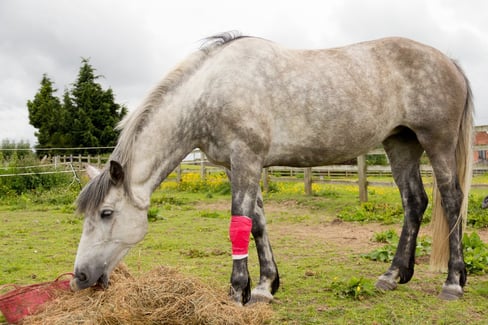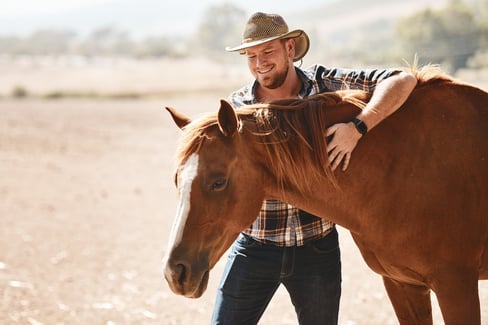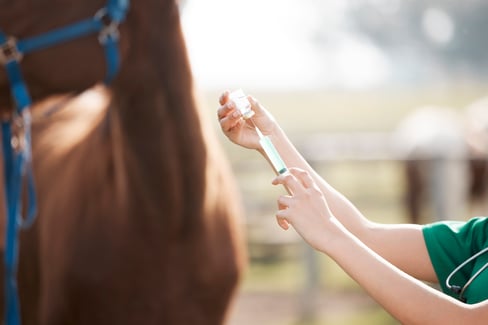Table of Contents
Sometimes, the smallest body parts make the difference between an active horse and a horse relegated to the stable. And in the case of the extensor tendon, this couldn’t be more true. Running down the front of a horse’s limb, the extensor tendon helps propel the horse forward alongside the cannon bone. When a horse extensor tendon injury occurs, you’ll notice your horse is unable to move as they normally would, and suddenly, you have a lame horse on your hands.
So what’s a horse owner to do? And how do you overcome a horse extensor tendon injury? We’ll discuss how you can brave this scary injury and ensure you’re prepared to fight a horse extensor tendon injury and other common tendon injuries with the help of equine tendon supplements. That way, you can get back in the saddle and ride into the sunset with your sweet equine in no time.
Tendon Injury Horse Types
Before we go too much further, it’s important to understand the role a tendon plays in your horse’s movement. Tendons are a structure that is essential to movement in any body, and in your horse, they are located throughout the body. These strong structures can often be mistaken for their similar-but-different counterparts, ligaments.
When your tendon injury horse problem occurs, it affects your horse differently than a ligament injury due to these functional differences:
- Tendons: Bands of fibrous connective tissue connecting muscles to bones. Tendons help horse muscles move and produce movement in the body.
- Ligaments: Bands of fibrous connective tissue that bind bones together. Ligaments act as stabilizers to the horse's bones and structures.
Now let’s break down a tendon injury horses may face further. There are actually two types of tendons to be familiar with that each play a unique role in movement:
- Horse Extensor Tendons: A flexor tendon is a structure along the backside of the limb that is designed to flex joints through relative movement between two bones.
- Horse Flexor Tendons: Located along the front side of the limb and straighten or extend joints through the relative movement of the bones on either side.
Depending on the location of your horse’s injury and whether or not an extensor or flexor tendon have been affected, their movement will be impacted differently. Check out the diagram below to see where some of these key tendons are located in a horse’s limb.
Now that you have the Anatomy 101 lesson on horse tendons, let’s discuss further tendon horse injury types. We’ll cover each of these in-depth in just a moment, but consult the table for a quick breakdown to avoid confusing these unique structures.
|
Tendon Horse Injury Types |
Description |
|
Tendon Sheath Horse Injury (Tenosynovitis) |
Inflammation and injury to the sheath of the tendon. |
|
Deep Digital Flexor Tendon Horse Injury |
Injuries to the tendon that runs down the back of the coffin bone and allows your horse to flex their leg and support the action of the heel. |
|
Superficial Digital Flexor Tendon Horse Injury |
Injuries in the fetlock joint, the superficial digital flexor tendon stabilizes and supports the structure. |
|
Digital Extensor Tendon Horse Hind Leg Injury |
Injuries to the tendon that runs down the front of the cannon and pastern bones. They are less common than other tendon injuries. |
Alright, with that overview in mind, let’s dive into the details about the different tendon injury horse types.
Tendon Sheath Horse Injury (Tenosynovitis)
The tendon sheath is a synovial "sleeve" that houses the tendon. The fluid within the tendon sheath produces a lubricating layer between the surface of the tendons and their surrounding structures. This prevents friction and wear, which helps to prevent damage to these structures.
There are three tendons that are commonly affected by tenosynovitis:
- Digital tendon sheath (DT)
- Carpal tendon sheath (CTS)
- Tarsal tendon sheath (TTS)
These three locations can be found on your horse's legs, forearm and back leg, respectively. Each area has specific tendons passing through them, so you will want to make sure you know where the horse's injury is located before beginning treatment plans.
Causes of tendon sheath horse injury and damage includes:
- Internal injury
- External injury
- Infection
- Age
The most common cause of tenosynovitis is an injury to the tendon sheath. This can happen when the tendon rubs against bone or cartilage and causes inflammation. The fluid in the sheath builds up, causing swelling and irritation that can lead to more serious problems if left untreated.
Another common cause is an infection, which can occur when bacteria enter the tendon sheath through a cut or scrape. This type of tenosynovitis will also cause swelling and irritation in addition to pain.
No matter the cause, a horse tendon sheath injury needs to be addressed and treated as soon as possible to prevent further problems. Tendon sheath injuries can be difficult to diagnose because they are often mistaken for other types of tendon injuries. If you suspect your horse has a tendon sheath problem, consult with your veterinarian to determine the best course of action.
Deep Digital Flexor Tendon Horse Injury
Deep digital flexor tendon horse injury, or DDFT for short, is a fairly common problem in horses. This tendon attaches to the bottom of your horse's coffin bone (the bone under the hoof wall at the front of the leg) at their hind leg and behind their heel. In addition to flexing their leg, it also serves as a support at the heel where fibres fan out to pass over the navicular bone.
Because this tendon must withstand so much pressure from both sides of its attachment point on each side of its body – the distal sesamoid bones – and because it does not have any bony protection like other tendons, it is prone to injury.
A deep flexor tendon horse injury can be a difficult problem to diagnose. This is because the horse may not show obvious lameness and other structures in this area could cause problems.
The risks that can lead to a deep digital flexor tendon horse injury can include:
- Jumping
- Galloping
- Conformation problems, particularly ones that affect breakover
- Poor shoeing
If you suspect a deep flexor tendon horse injury has occurred in your horse, call your veterinarian immediately so that they can properly examine your equine and begin treatment if needed.
Superficial Digital Flexor Tendon Horse Injury
Superficial digital flexor tendon injuries in horses are injuries that affect the superficial digital flexor tendon. This tendon connects the short pastern to the coffin bone and is located on the cannon bones of each fore and hind leg.
Each superficial digital flexor tendon acts independently, but they both work together to stabilize and support fetlock joints when a horse shifts their weight from one foot to another. An injury can occur suddenly after a fall or blow from another limb or gradually after being overworked, causing it to weaken over time.
Symptoms of this kind of tendon horse injury include:
- Swelling behind each cannon bone (toes)
- Heat around those areas
- Pain upon touch around those areas/painful response when palpated for soreness
- Refusal by your animal to switch leads between feet during regular walking patterns such as trotting
If you suspect that your horse may have suffered an injury here, then be sure not only to seek out immediate veterinary attention but also to avoid continuing to work your horse and get them to a safe and comfortable place to rest.
Extensor Tendon Horse Hind Leg Injury
Extensor tendons run down the front of the pastern and cannon bones. They are responsible for straightening a horse's leg after lifting it up. These tendons do not experience heavy loads as frequently as other structures, making them less likely to suffer from overstraining injuries. Injuries tend to come from external trauma more often than internal injuries.
Hind extensor tendon injuries can cause lameness and pain in the hind legs and may result in swelling, stiffness, and lack of mobility if left untreated.
The severity of this horse tendon injury depends on several factors:
- Where exactly it occurred
- What type of activity was being performed at the time
- Whether there were any other associated injuries or old horse tendon injuries
The sooner you seek treatment for a tendon injury like this, the better. If left untreated, it can lead to chronic lameness and pain.
Causes of Horse Injury Tendon Problems
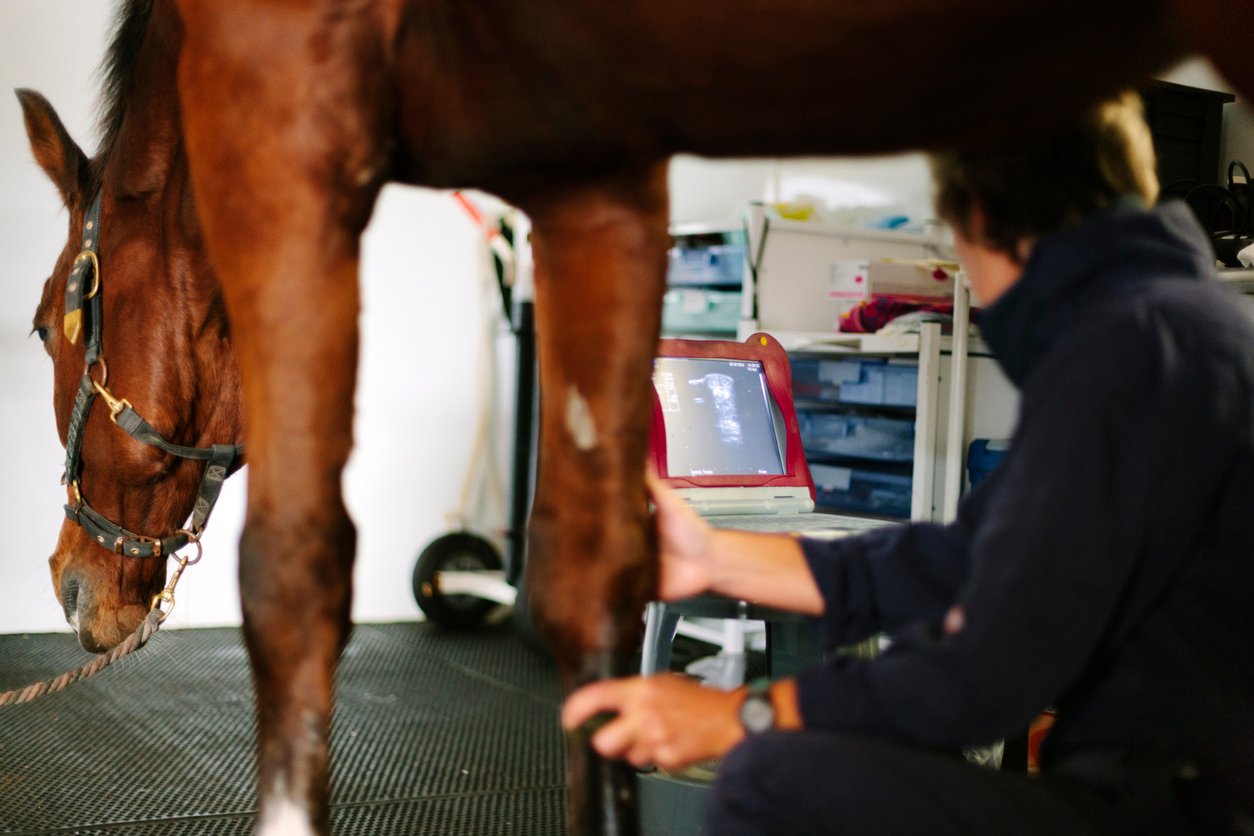
The causes of horse injury tendon problems can be vast. Because there are so many different tendons in a horse’s body, you can imagine injuries really depend on what your horse is doing, where they are, and how they are moving.
That said, most causes of horse injury tendon problems can be grouped into one of a few categories:
- Injuries caused by exercise and movement
- Injuries caused by a breakdown of tissues
- Injuries caused by sudden external trauma during motion or otherwise
With these high-level categories in mind, let’s discuss how painful horse injury tendon problems often happen, so you can be careful to avoid putting your horse at risk.
Cause #1: Exercise-related
As much as a tendon is flexible like a rubber band of tissue, it can become injured when it is stretched beyond its capacity or if it is torn. This can often happen when your horse is exercising or moving, which is why exercise is one of the most common causes of tendon problems in horses.
Some of the most common occurrences of tendon injuries during exercise include:
- Horseback riding activities that increase your horse's speed or weight-bearing activity
- Excessive exercise on hard surfaces or uneven terrain
- Overuse of a particular muscle group (such as overworking one side of the body)
- Incorrectly fitting tack (such as a saddle that does not fit properly)
Horses can also suffer injuries when they work too hard under the saddle before their muscles are warmed up enough or after being ridden too long without giving them time for recovery between rides. If your horse seems stiff or sore after riding or exercising, it could be an early sign of how to tell if a horse has a tendon injury.
Cause #2: Degradation
Injuries to the tendons of the horse are often caused by a breakdown over time of the connective tissues that support these structures.
The most common tendon degenerative-type issues in horses are:
- Distal suspensory ligament desmitis (DSLD)
- Arthritis
- Tendinosis
Each of these conditions has a different effect on the horse’s body. Review the key differences between these three conditions in the table below.
|
Horse Injury Tendon Degradation Injury |
Description |
|
Distal suspensory ligament desmitis (DSLD) |
Distal suspensory ligament desmitis (DSLD) is a condition common in racehorses and breeds like Peruvian Pasos and Arabians where there is degeneration of connective tissues like tendons in the lower limbs. |
|
Arthritis |
Arthritis is a disease that causes inflammation of a joint. This is usually caused by trauma to the joint, age-related changes in the joint cartilage or bony growths on the joint surface. Arthritis can cause lameness and pain in the affected horse's joints, muscles, and tendons. |
|
Tendinosis is a degenerative disease of the tendon that results from repetitive strain on the tendon, causing a loss of collagen. It is most commonly seen in racehorses, jumping horses and eventers due to the high-intensity work they perform. The cause of tendinosis is unclear, but it may be related to overuse (strain) or microtrauma (tiny tears) within the tendon, which causes inflammation and pain. |
Cause #3: External Trauma
Horse tendon injuries are often caused by external trauma. A tendon injury like this is a tear or rupture of the tendon, which is the tissue that attaches muscle to bone. Traumatic injuries vary in severity depending on the type of trauma sustained by the horse.
Causes of external traumatic horse injury tendons include:
- Cuts
- Bruises
- Contusions (bruising without a break in the skin)
- Lacerations (cuts)
- Avulsions (when a tendon is torn away from its attachment point)
The severity of these injuries depends on how much damage they do to the tendons themselves. A cut could cause bleeding into the tendon sheath, or an avulsion could tear part of the tendon off.
The most common cause of tendon injury in horses is a laceration. A laceration occurs when the horse's leg hits something, such as wire fencing, causing the skin to tear and exposing the muscle and tendons underneath. The sharp edges can cut through tendons, causing them to tear or rupture completely.
Equine Tendon Repair Treatments
If you suspect your horse has a tendon injury, or is exhibiting tendon injury horse symptoms, you should contact your veterinarian. They will want to examine the leg and possibly X-ray it. The veterinarian may also recommend other tests, such as blood work, to determine whether the injury is serious enough to require surgery for equine tendon repair.
In most cases, the best treatment for equine tendon repair is rest. Your horse needs to stay off their legs for several weeks or months. This means not riding them or letting them do any strenuous activity.
If your horse has suffered a more serious injury, other treatments may be recommended for your horse's extensor tendon injury or other injuries to their tendons.
Equine tendon repair techniques can include:
- Regenerative therapies like PSAG injections
- Medications to manage pain and inflammation
- Surgery to repair broken tendons
- Horse supplements
Depending on the severity of your horse’s injury, different treatments can be used to help get them back on their hooves. The table below outlines the primary treatments for a horse extensor tendon injury, as well as the appropriateness of each depending on the severity of the injury.
|
Horse Extensor Tendon Injury Treatment |
Severity Level for Injury Treatment |
What It Is |
|
Supplements |
Mild to Severe, as well as preventative |
Tendon injuries may be treated with supplements that contain chondroitin and glucosamine for horses. These supplements help build new collagen fibers and contribute to healthy cartilage, which are the building blocks of all connective tissue in the body, including tendons and ligaments. |
|
Regenerative Therapies |
Mild |
These therapies help promote healing by stimulating blood flow around injured areas and encouraging growth of new cells within damaged tissue. They include platelet-rich plasma therapy (PRP), stem cell therapy and prolotherapy. |
|
Medication |
Mild to Severe |
A veterinarian may prescribe anti-inflammatory medications such as phenylbutazone (Bute) or flunixin meglumine (Banamine). These nonsteroidal anti-inflammatory drugs (NSAIDs) are commonly used for treating tendon injuries because they reduce pain and swelling. In addition, corticosteroids may be administered to help decrease inflammation. |
|
Surgery |
Severe |
Surgery is sometimes performed in the case of tendon lacerations in horses. The purpose of surgery is to repair damaged tendons so that they can heal properly with minimal scar tissue formation and loss of function. Tendon repair surgery is also used after some types of ligament injuries with significant damage from trauma. |
Best 3 Horse Tendon Supplements
Supplements are often used to help horses heal from injuries. The most common supplements for tendon injuries in horses include glucosamine, MSM, and chondroitin.
But not all supplements are created equally, so it’s important to know which ones are the best for your horse. We’re going to share our favourite horse tendon supplements for exactly that reason so you can avoid bad supplements and make sure your sweet horse gets the best of the best.
Ready to saddle up and supplement your horse for healthier tendons, ligaments, and joints? Let’s get into it!
Integricare’s TRI-ACTA for Equine
When you’re searching for horse tendon supplements that checks off the boxes of a high-quality product, TRI-ACTA for Equine fits the bill with:
- No filler
- A list of active ingredients that target joint and tissue health including MSM, chondroitin, and glucosamine
- Third-party testing
- Health Canada approval as a Veterinary Health Product
- Small yet effective serving sizes
TRI-ACTA for equine is one of the best ways to protect and repair horse extensor tendon injury problems. It offers your horse a 100% active dose of glucosamine, chondroitin and MSM. Each of these ingredients helps to reduce symptoms like pain and inflammation while rebuilding and repairing cartilage and tissues.
And for our friends who are trotting into old horse territory – try our extra-strength TRI-ACTA H.A. for Equines. This formula combines the benefits of our regular strength TRI-ACTA product with hyaluronic acid to increase synovial fluid supply and viscosity -- helping their mobility improve, too.
TRI-ACTA H.A. for Equine
Our maximum strength formula is perfect for horses that are ageing, experiencing arthritis and stiffness, are in training and competition, or under a heavy workload.
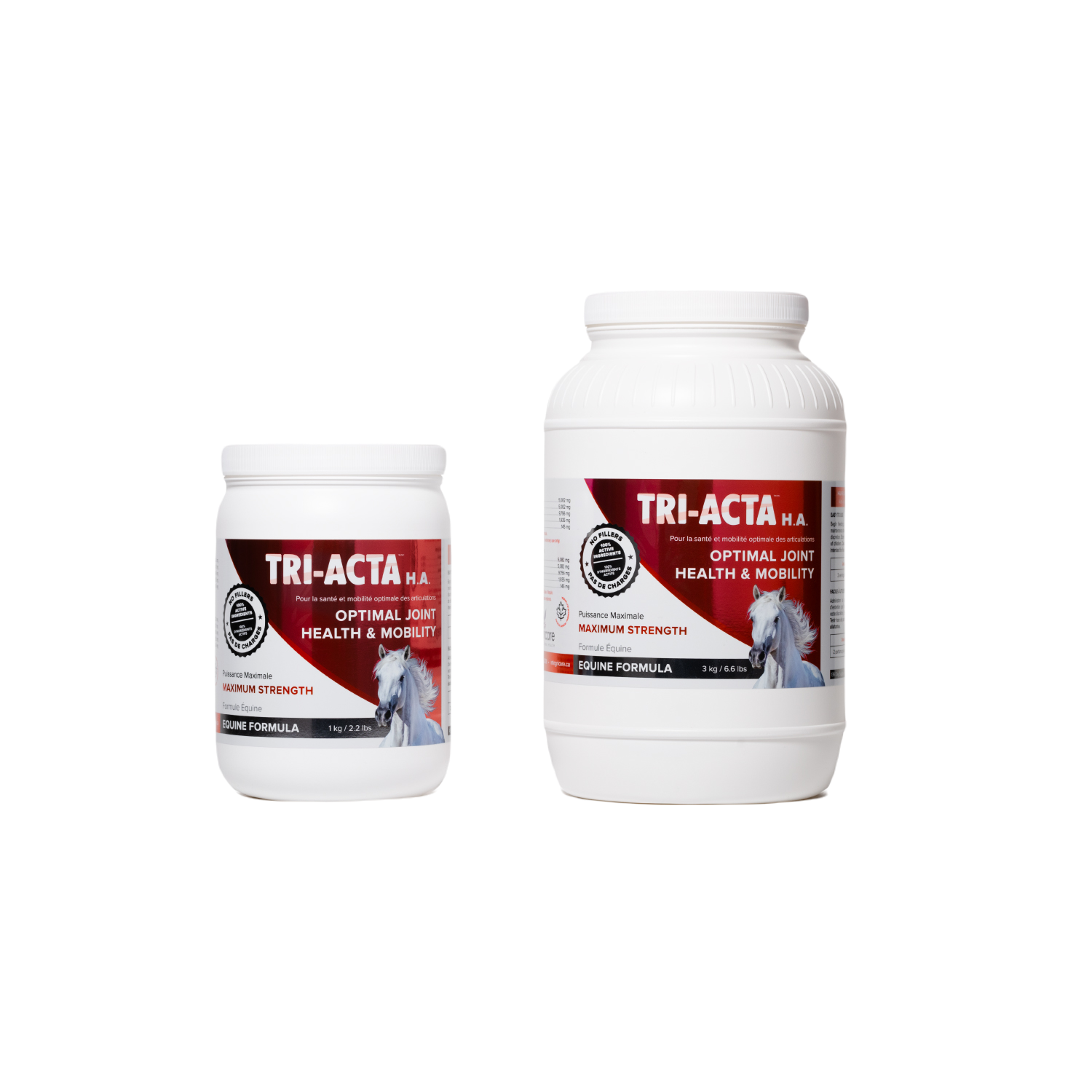
SmartTendon Pellets
SmartTendon's blend provides targeted support for tendons and ligaments to help prevent your horse and recover from tendon injuries.
These pellet-type horse tendon supplements contain ingredients including:
- Collagen: Helps keep your horse's tendons and ligaments strong and healthy.
- Silica: A trace mineral that is essential for the health of connective tissue.
- MSM: Helps tissues withstand the damaging effects of exercise and stress.
- Vitamin C: A key player in the production of connective tissue.
This supplement is designed to be used alone or alongside joint health supplements to give your horse maximum internal support.
Equine Challenge Joint, Tendon, and Ligament
Equine tendon supplements like this offering from Equine Challenge are perfect for promoting the healing of connective tissue, especially in injuries involving a horse’s extensor tendons. It supports hard-working equines and contains no fillers – ideal for those who want to keep their horses healthy!
We like that this offering provides day-to-day support for the equine athlete and assists in recovering injuries, such as a horse extensor tendon injury.
In Conclusion
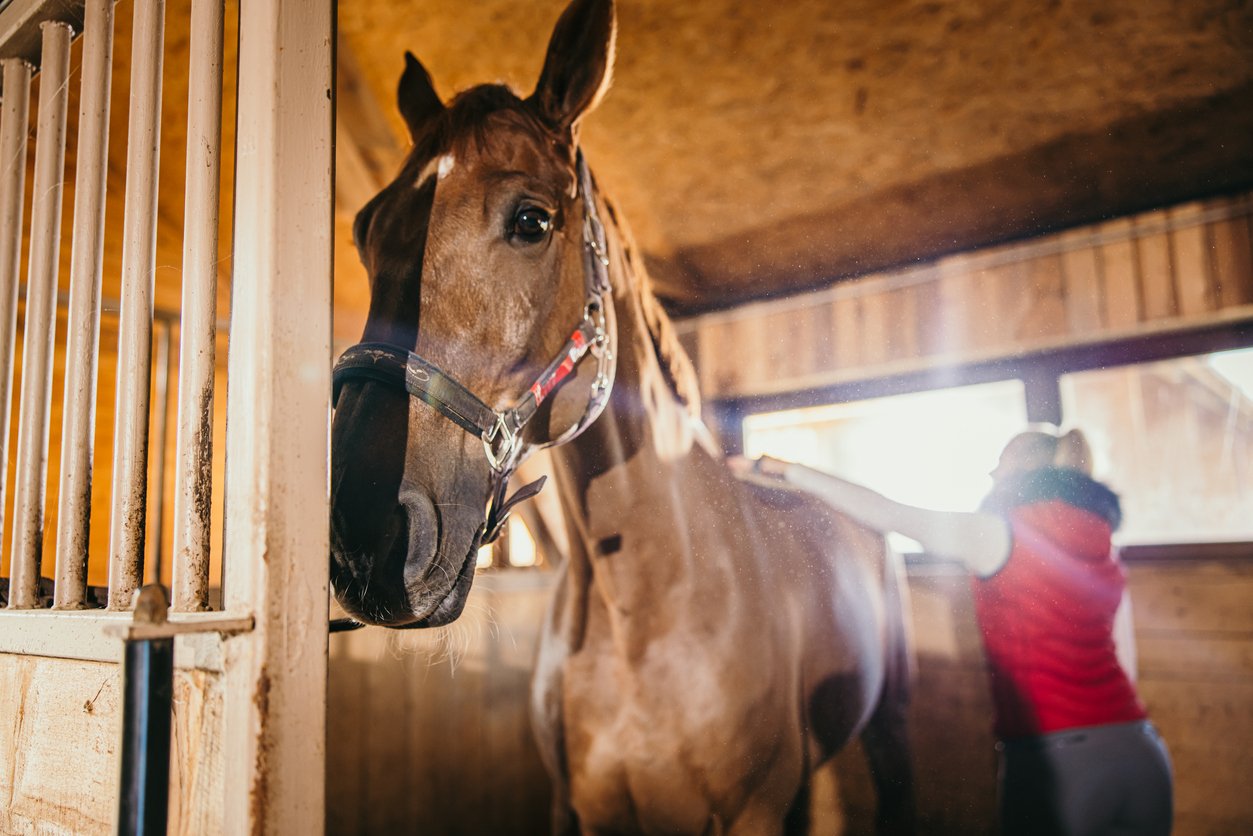
Hopefully, this article has put you on a better path toward tackling a horse extensor injury. The biggest thing to remember? Seek out a professional if you have any concerns about your horse's health. If you wait and see if things improve on their own, you could miss valuable time in the treatment process.
And something you can do to both prevent and treat a horse extensor tendon injury? Add an equine supplement like TRI-ACTA. Whether your horse needs protective, preventative care and is using TRI-ACTA for Equine, or is a senior or previously injured horse that is taking advantage of the extra power in TRI-ACTA H.A. for Equines, Integricare is a brand you can trust to help make your horse feel better.
Learn more about horse health on our blog, and check out where you can buy TRI-ACTA for equines near you.
TRI-ACTA H.A. for Equine
Our maximum strength formula is perfect for horses that are ageing, experiencing arthritis and stiffness, are in training and competition, or under a heavy workload.

Newsletter Signup
Subscribe to our newsletter to receive the latest news and exclusive offers.
.jpg?height=2000&name=Cliick_Integricare-DISPLAY-REVISEDV2%20(1).jpg)
Proactive & Therapeutic Joint Supplements
When given daily, Integricare joint supplements recover bone and joint injuries faster and help prevent mobility injuries from happening in the first place.







